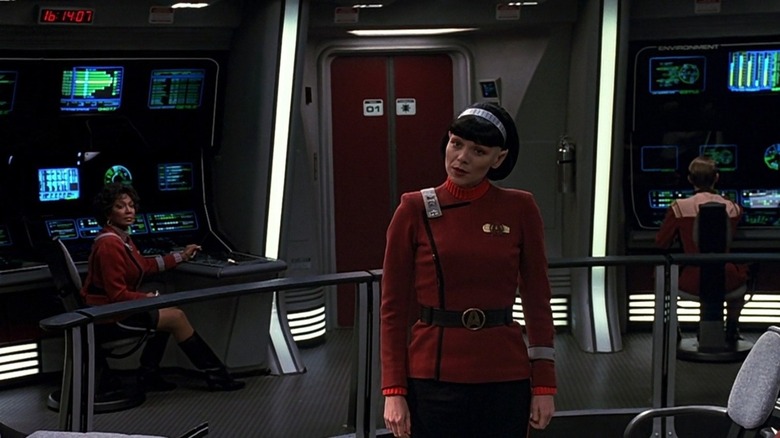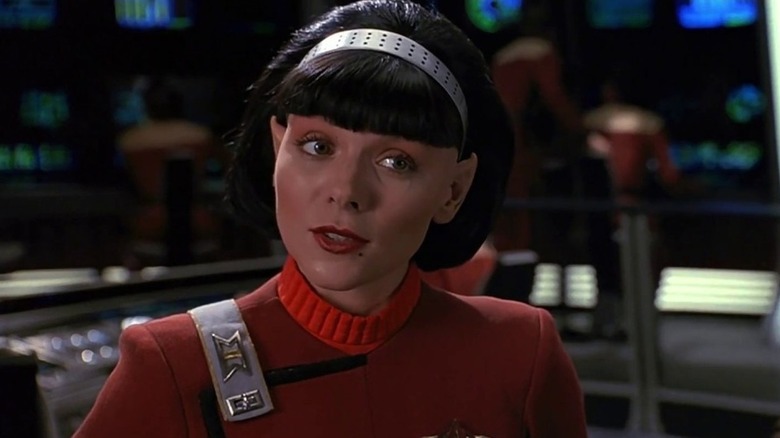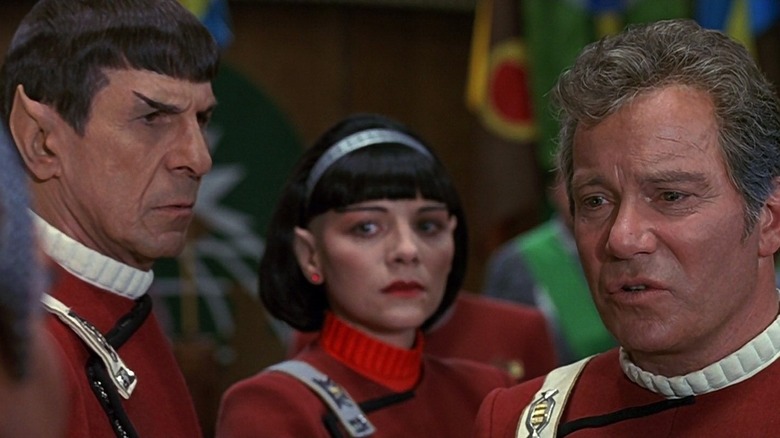Kim Cattrall's Only Star Trek Complaint Was About A Lack Of Leg
People old enough to remember the "Police Academy" movies may recall a scene in Hugh Wilson's 1984 original might recall a scene wherein the irascible horndog Carey Mahoney (Steve Guttenberg) sidled up to fellow cadet Karen Thompson (Kim Cattrall) and asked to see her thighs. Karen was too flustered in the moment to respond, but was eventually won over by Mahoney's comedic charm and loose manners in the face of the Metropolitan Police training facility. She eventually donned a pair of jogging shorts and, of her own accord, playfully showed them off to Mahoney while in the middle of her morning run.
The "Police Academy" movies are, naturally, horrendously dated in their attitudes today, but Kim Cattrall likely didn't object to the jogging shorts scene as, it so happens, she is quite fond of her own legs. It was that fondness, it seems, that led to a minor disappointment when Cattrall agreed to appear in Nicholas Meyer's 1991 film "Star Trek VI: The Undiscovered Country." In that film, Catrall played the Vulcan helmsperson Valeris, a brilliant young officer who is being trained as a replacement for Spock (Leonard Nimoy) when he retires. Valeris is a confident, intelligent, almost brash character who, it will eventually be revealed, has secrets of her own. She is a great addition to the cast.
Valeris, like most Starfleet officers, wore the usual red shirt/black slacks uniform while on duty. Long gone are the days when female Starfleet officers would wear go-go boots, black leggings and solid-colored minidresses. It seems that this costume change wasn't to Cattrall's liking as, well, she wanted a minidress. In the book "The Fifty-Year Mission: The Complete, Uncensored, Unauthorized Oral History of Star Trek: The First 25 Years," edited by Mark A. Altman and Edward Gross, Cattrall reminisced.
Listen all y'all it's a...
Cattrall recalls growing up with "Star Trek," and was very fond of the fashions therein. For the three seasons "Star Trek" was on the air, the uniforms remained largely the same; color-coded tunics and black slacks for the men, minidresses for the women, notably for Uhura (Nichelle Nichols). It wouldn't be until "Star Trek: The Motion Picture" in 1979 that the uniforms would be changed, and it wouldn't be until Meyer's 1982 sequel, "Star Trek II: The Wrath of Khan," that the red-shirt, more militant uniforms would be codified for the era.
Meyer's militant uniforms look nice, but they are also thick and boxy with high collars and multiple layers; there's a Christmas sweater quality to them. Cattrall hated the thick-and-boxy look, preferring clothing and costumes that were more form-fitting and revealing. Meyer was a little bit taken aback by Cattrall's request to show off her own legs. She said:
"I told Nick I really wanted to wear a skirt, like Uhura, since I have great legs. He said, 'Kim, if I put you in a skirt, people will be looking at your legs.' And I said, 'So?' The uniforms are nice, but they were made in 1982 for someone else. I really wanted a new uniform, but when they fitted me for a costume they told me they couldn't get any more material. I didn't want to sweat in someone's old jacket. I had to completely reshape it so I'd look like a woman."
Cattrall didn't get to wear the skirt, but one might note that Valeris' uniform is indeed cut slightly differently than the other chatacters'.
Gendered uniforms
Cattrall continued:
"I wasn't into hiding things at that point in my life. I feel good about the way I look and as a woman I enjoy feeling sexy. I think in science fiction, women should look great ... and so should men. That's why people go to the movies."
Cattrall, of course, makes a basic point about cinema that some filmmakers often adhere to: in a visual medium, why not cast the people you find to be the most attractive? Joel Schumacher once said very frankly that casting attractive actors and dressing them well is one of the basic appeals of film. Cattrall seems to share that belief. Meyer, meanwhile, seemingly wanted to lean into a more formalized version of "Star Trek" wherein the uniforms were less gendered.
"Star Trek" has struggled with gendered uniforms for decades. The minidresses were briefly repurposed for "Star Trek: The Next Generation" in 1987 when several male officers were seen wearing them, implying that it was a mere uniform style choice and not a gendered mandate from Starfleet. That, however, didn't stick. Eventually, "Next Generation" made its way to a one-size-fits-all type of uniform, perhaps following the ethos laid down by Meyer with "Star Trek II," five years earlier.
Cattrall, however, wanted to defy the utilitarian nature of Starfleet uniforms, and make them more fashionable. One can admire her dream, although it wouldn't necessarily have fit in with the terse, socio-political tone of "Star Trek VI," a film about governmental turmoil, Cold War, and assassinations.
Her performance remains quite good, however.


